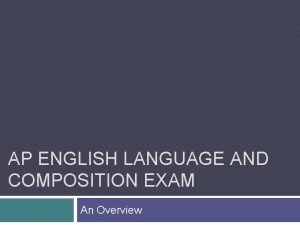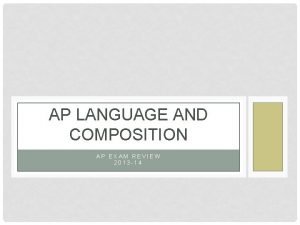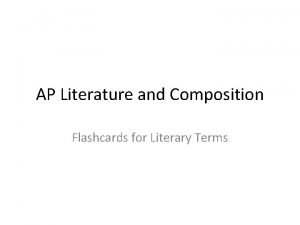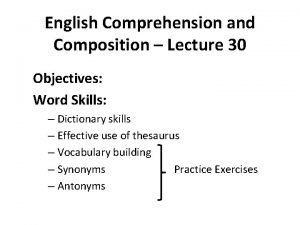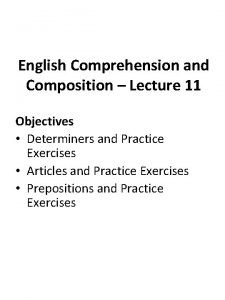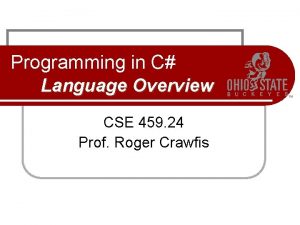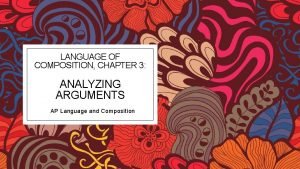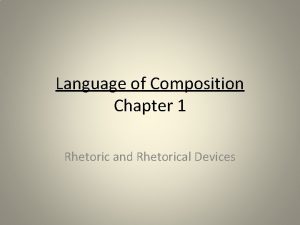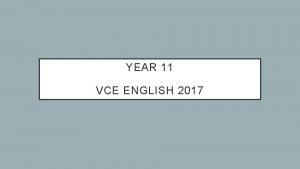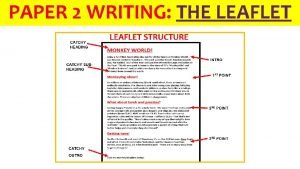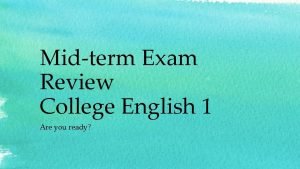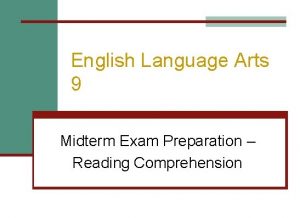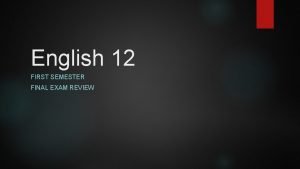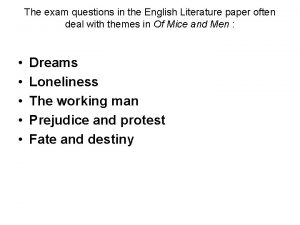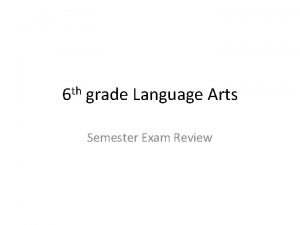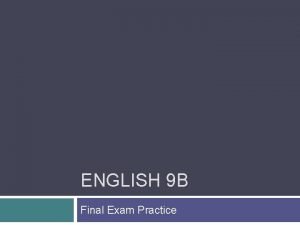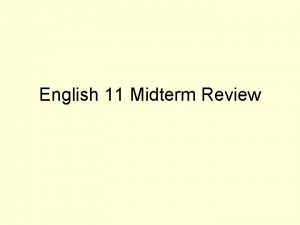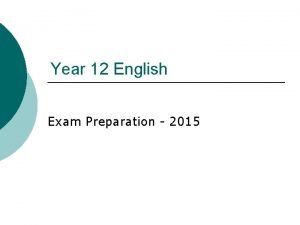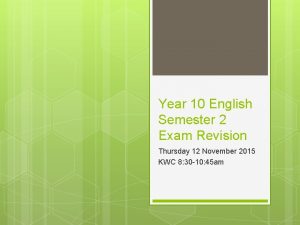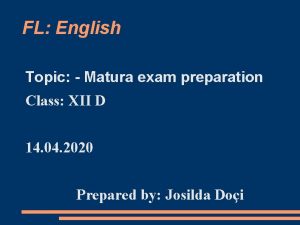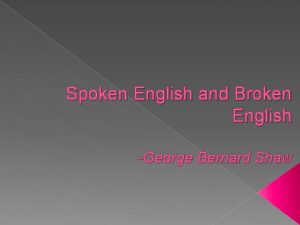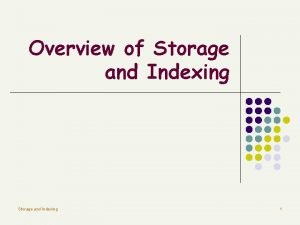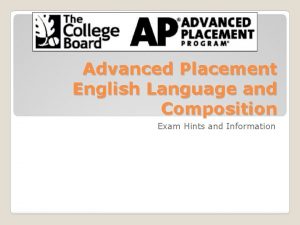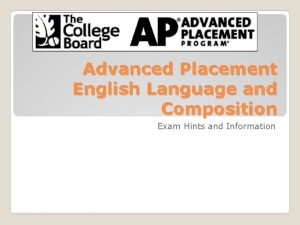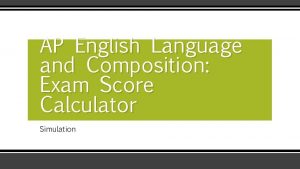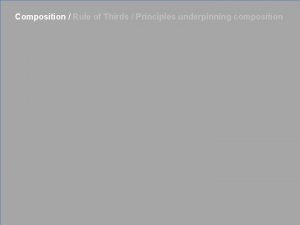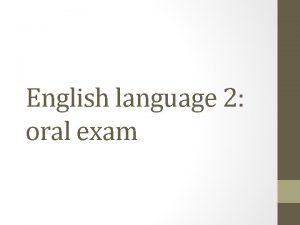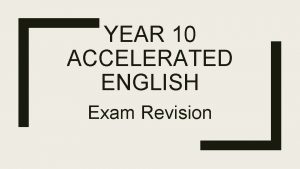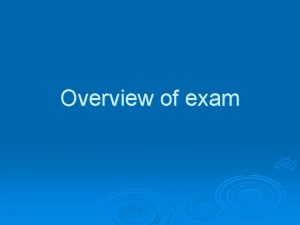AP ENGLISH LANGUAGE AND COMPOSITION EXAM An Overview










































- Slides: 42

AP ENGLISH LANGUAGE AND COMPOSITION EXAM An Overview

Test Format SECTION ONE SECTION TWO Multiple Choice 60 Minutes 50 -60 Questions 45% of your total score THREE Essay Responses 120 minutes Analysis = 40 minutes Synthesis = 40 minutes Argument = 40 minutes

Overall Scoring 5 = exceptionally qualified (college credit likely) 4 = well-qualified (college credit probable) 3 = qualified (college credit possible) 2 = possibly qualified (college credit unlikely) 1 = not qualified (college credit not possible) NOTE: If you are concerned, check with individual colleges to confirm acceptability.

Section One Multiple Choice

Section One Reading Passages Four passages of nonfiction an excerpt from a 17 th-19 th British writer a passage written by an American author from a particular ethnic background a nonfiction passage that includes footnotes a contemporary (last 50 yrs)excerpt

Reasons to Annotate Not possible to Helps you keep your remember concentration everything from one Notes make it easier reading to work through the To avoid wasting multiple choice valuable time going questions over the passage repeatedly ANNOTATION: To engage in a written dialogue with the text

What to Annotate in Section One YOU SHOULD ALSO ANNOTATE THE ANSWER CHOICES. ü ü ü ü Identify any clear statement of the argument or thesis. For each and every point, identify the kind of argument. Identify any figurative language. Mark any shifts in point of view or tone. If you find parallel syntax, note it. Underline unfamiliar vocabulary and use context clues to write a meaning in the margins. Recognize any bold claims or obviously false arguments.

Timing Strategies for Section One You should try to spend no more than 5 minutes reading and annotating a passage. That leaves you approximately 10 minutes to answer between 10 -15 questions about that passage. 4 passages x 15 minutes each = 60 minutes

General Advice for Section One Remember that test makers designed this test to be challenging. You can pass this section of the test by getting roughly 50 percent of these questions correct. NEW for 2011: NO points will be deducted for each incorrect answers. You lose the chance to earn a point for skipping an answer, like the SAT. If you can eliminate two choices, you are better to guess than leave an item blank.

More General Advice—Section One The multiple choice questions are NOT arranged from easiest to hardest. There are often several questions that deal with the passage as a whole. The rest are specific line or paragraph questions. Generally they are arranged sequentially. From the beginning of the passage To the end of the passage Don’t get discouraged! A challenging question could likely be followed by an easier one. BE CONFIDENT!!!!

Attacking the Questions • • • The AP exam is a contest of intellect and stamina. Do not let the questions come to you—GO AFTER THEM! Succeeding on this test has a great deal to do with attitude! You cannot be arrogant, but you must feel that you are intellectually capable of handling the test.

Section Two Essays

How Essays are Scored Essays are scored 0 -9. Scores of 4 -1 are considered weaker to unacceptable essays. Scores of 5 -9 are considered acceptable to excellent essays.

General Information-Section Two At first, you receive only a green booklet. You will get 15 minutes to read annotate the material in this booklet. Then, you will be given a pink booklet. You then have two hours to write three essays.

What Scorers Look for in an Essay THREE MAJOR ELEMENTS Does the student answer the question? Does the writer’s point remain clear? Does the student use examples effectively?

What Scorers Look for in an Essay OTHER IMPORTANT CONSIDERATIONS Grammar Perfection is not expected. Errors cannot, however, compromise overall readability. Scorers acknowledge it as a rough draft. Voice Have your own style, but don’t become overly fixated on the beauty of your prose. Scorers are drawn to essays that are not only grammatically correct and to the point but that don’t

What Scorers Look for in an Essay MORE ABOUT GRAMMAR When responding to the prompts, show your understanding of syntax by using some of the following terminology in your own responses.

Sentence Types Simple Needs a subject and a verb EX: Carly and Rick waited for the bus. Compound Uses a conjunction to connect two simple sentences. EX: Carly and Rick waited for the bus, but the bus never came for them.

Sentence Types Complex Contains an independent clause and at least one dependent clause EX: While Carly and Rick waited for the bus, they decided to play a game of cards. Periodic The main clause is withheld until the end of the sentence EX: A harmful economic system develops when a worker cannot get a job that pays enough to support a family.

Parts of Speech Noun Describes a person, place, thing or idea EX: Sadness crept its way into her bleeding heart. Verb Shows action or condition about a noun EX: Sadness crept its way into her bleeding heart. EX: The winter seems harsher than usual. Pronoun Replaces a noun EX: While Carly and Rick waited for the bus, they decided to play a game of cards. Adjective Makes a noun more specific Answers…what kind? How many? Which one? How much? EX: Sadness crept its way into her bleeding heart.

Parts of Speech Adverb Makes verbs, adjectives, and other adverbs more specific Answers…Where? When? How? To what extent? EX: The fish swam quite rapidly. EX: Then I decided to quit my job. Conjunction Interjection Preposition Words that begin a phrase that ends in a noun or pronoun but are neither subjects or verbs EX: We saw a squirrel in the park. Connects words, phrases and clauses EX: He met me at work because I forgot my keys. Shows emotion and is separate from the sentence EX: No, I do not want to go with you to the prom.

Basic Sentence Parts SUBJECT PREDICATE A complete subject includes: A noun or pronoun that the sentence is about EXAMPLE: arena. A complete predicate includes: A verb or verb phrase that tells something about the complete subject The three clowns in the ring complete subject tumbled around the complete predicate

Basic Sentence Parts PHRASES CLAUSES (DEPENDENT) A group of words, without a subject or verb, that functions in the sentence as one part of speech EXAMPLE: the roads. A group of words with its own subject and verb but cannot function as a sentence Unless the rain stops soon, the rivers will flood into dependent clause phrase

THE SYNTHESIS ESSAY

Purposes of the Synthesis Essay To ensure that you are able to present and support an argument. To examine your ability to consider and support a rational argument To evaluate your ability to absorb, understand, and employ several sources on the same topic

Recommendations Use your 15 minute reading and annotation period to prepare to write THIS essay. Do what the prompt asks you to do. Present your own opinion. QUOTE OR PARAPHRASE AT LEAST THREE SEPARATE SOURCES IN YOUR ESSAY!!!!!!

The Initial Question Page THREE SECTIONS DIRECTIONS You will find a crucial sentence: “Your argument should be central; the sources should support this argument. Avoid merely summarizing. ” INTRODUCTION • Its purpose is to get you thinking about the issue. • This material is NOT the prompt. • DO NOT address an idea presented in the introductory material if it is not central to the assignment. ASSIGNMENT THIS IS THE PROMPT!!!! It is highlighted in bold type. In this section, you are specifically instructed to “synthesize as least three sources for

Questions to Ask Yourself As you read the sources for the synthesis essay, ask yourself the following questions: Is the source biased? Does the source’s date of publication have an effect on the relevance of the argument? What position (pro/con/neutral) does the author hold? For what audience is the author writing?

Annotation of the Synthesis Sources You should critically annotate the passages by identifying: the point of view or thesis of the sources any “quotables” (particularly succinct phrases you the need to reference the visual (or not)

Using Multiple Sources Using Enough Passages Time is of the essence—do not feel the need to use ALL of the sources (or even more than three). Using Opposing Passages It can be an effective strategy to strengthen your own argument. Don’t avoid these sources just because they do not overtly support your opinion. DISPROVE THEM. NOTE: You may use more than three sources. NOTE: You may use the same source more than once.

THE RHETORICAL ANALYSIS ESSAY

Purpose of the Rhetorical Analysis Essay To analyze the methods the author employs in his or her writing to convey the author’s attitude, opinion, or conviction about some topic.

The DOs and DON’Ts What NOT to Do address the author by his/her first name use fancy language write a “hokey” review It’s good. It’s bad. What to DO Instead ü ü Remember to identify and explain specific strategies employed by the author Use textual evidence to support your analysis, not confirm your summary

Chief Areas to Analyze Diction Notice author’s word choice, especially connotation Syntax Dissect the sentence structures, parallelism, questions, and repetition Figures of Speech Recognize the metaphors, allusions, imagery, etc. More important, explain their function in the passage for the reader Rhetoric

Rhetoric, an acronym of strategies P-----E-----L-----I-----D-----S P is for PATHOS—direct appeal to emotions E is for ETHOS—an argument about credibility L is for LOGOS—a rational and reasonable argument I is for INDUCTIVE—logos that is based on examples D is for DEDUCTIVE—logos based on assumed truths

Reminders about Rhetorical Analysis It is probably the essay most UNLIKE the writing you find to be natural. It is more natural to engage in debate than to analyze the truth or effectiveness of an argument. Take the time to closely read the material and consider the persuasive purpose and how it is achieved.

GENERAL ARGUMENT ESSAY

The Basics of the Third Essay Designed as a “contemporary issues” question Really is more like a “values” question Fundamental issues inherent to this type of question are: What are your values? What do you think our society should value? What should a moral, thoughtful and reflective society consider its most important strengths?

The Prompt This is considere d the easiest of the essays to write. The prompt is set up by a brief excerpt. Could be as long as half a page Could be as brief as two lines An opinion is offered in the passage. You are asked to agree, disagree, or qualify that opinion based on your own experiences and/or reading.

Three-Step Process Step 1 Step 2 Step 3 • Read and understand the claim • Restate claim in your own words • Jot down your immediate reactions • Write if you are for it, against it, ambivalent • Create a brief outline of why • Make a list of viable, thoughtful examples • Choose examples that can help you illustrate your argument

Preparation One proactive step you can take to ensure success in writing the general music books TV argument essay is: shows current global events local happening s family stories to create a sample list of works and experiences to draw upon when considering what you will write in this essay volunteer work religious references personal successes, failures, and lessons learned movie s historical people and events

Final Reminders Don’t forget to write in the present tense. Underline titles. Pay attention to proper capitalization. Always consider point of view and audience. Don’t just identify/label devices. Explain their functions. Responses must be multi-paragraphed. Never skip the conclusion. Budget your time!
 Ap english language and composition exam format
Ap english language and composition exam format Ap english language and composition midterm exam
Ap english language and composition midterm exam Ap literary terms
Ap literary terms English comprehension and composition
English comprehension and composition Determiners of comprehension
Determiners of comprehension C language overview
C language overview Ap language and composition crash course
Ap language and composition crash course Levels of language knowledge
Levels of language knowledge Claim of value examples
Claim of value examples The language of composition chapter 1 notes
The language of composition chapter 1 notes Vcaa english exam 2017
Vcaa english exam 2017 English semester 2 final exam
English semester 2 final exam Situational irony def
Situational irony def Write a leaflet
Write a leaflet English 10 midterm exam answers
English 10 midterm exam answers English 9 midterm exam
English 9 midterm exam English 12 semester 1 final exam
English 12 semester 1 final exam Of_mice_and_men study guide answer key (1)
Of_mice_and_men study guide answer key (1) English 3 fall semester exam review
English 3 fall semester exam review English ii final exam
English ii final exam Her husbands wallet was full of curious items
Her husbands wallet was full of curious items English 11 midterm exam
English 11 midterm exam 2015 english exam
2015 english exam English semester exam
English semester exam English 10 b final exam
English 10 b final exam Reading comprehension matura
Reading comprehension matura Spoken english and broken english
Spoken english and broken english Difference between british and american english
Difference between british and american english What's the difference between american and british english
What's the difference between american and british english Spoken english and broken english summary
Spoken english and broken english summary British english
British english Perbedaan replikasi virus dna dan rna
Perbedaan replikasi virus dna dan rna Data quality and data cleaning an overview
Data quality and data cleaning an overview Group of carbon
Group of carbon Chicago time
Chicago time Multicullar
Multicullar An overview of data warehousing and olap technology
An overview of data warehousing and olap technology Data quality and data cleaning an overview
Data quality and data cleaning an overview Data quality and data cleaning an overview
Data quality and data cleaning an overview Overview of storage and indexing
Overview of storage and indexing Chapter 17 overview elements and their properties
Chapter 17 overview elements and their properties Edexcel igcse english language young and dyslexic
Edexcel igcse english language young and dyslexic English language a level eduqas
English language a level eduqas
